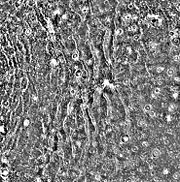
Valhalla (crater)
Encyclopedia

Impact crater
In the broadest sense, the term impact crater can be applied to any depression, natural or manmade, resulting from the high velocity impact of a projectile with a larger body...
) on Jupiter
Jupiter
Jupiter is the fifth planet from the Sun and the largest planet within the Solar System. It is a gas giant with mass one-thousandth that of the Sun but is two and a half times the mass of all the other planets in our Solar System combined. Jupiter is classified as a gas giant along with Saturn,...
's moon
Natural satellite
A natural satellite or moon is a celestial body that orbits a planet or smaller body, which is called its primary. The two terms are used synonymously for non-artificial satellites of planets, of dwarf planets, and of minor planets....
Callisto
Callisto (moon)
Callisto named after the Greek mythological figure of Callisto) is a moon of the planet Jupiter. It was discovered in 1610 by Galileo Galilei. It is the third-largest moon in the Solar System and the second largest in the Jovian system, after Ganymede. Callisto has about 99% the diameter of the...
and in the Solar System
Solar System
The Solar System consists of the Sun and the astronomical objects gravitationally bound in orbit around it, all of which formed from the collapse of a giant molecular cloud approximately 4.6 billion years ago. The vast majority of the system's mass is in the Sun...
. It was named after Valhalla
Valhalla
In Norse mythology, Valhalla is a majestic, enormous hall located in Asgard, ruled over by the god Odin. Chosen by Odin, half of those that die in combat travel to Valhalla upon death, led by valkyries, while the other half go to the goddess Freyja's field Fólkvangr...
, Odin
Odin
Odin is a major god in Norse mythology and the ruler of Asgard. Homologous with the Anglo-Saxon "Wōden" and the Old High German "Wotan", the name is descended from Proto-Germanic "*Wodanaz" or "*Wōđanaz"....
's hall in Norse mythology
Norse mythology
Norse mythology, a subset of Germanic mythology, is the overall term for the myths, legends and beliefs about supernatural beings of Norse pagans. It flourished prior to the Christianization of Scandinavia, during the Early Middle Ages, and passed into Nordic folklore, with some aspects surviving...
. Valhalla consists of a bright central region 360 km across, an inner ridge and trough zone and striking concentric rings extending up to about 1,900 km from the center. Several large impact craters and catenae
Crater chain
A crater chain is a line of craters along the surface of an astronomical body. The descriptor term for crater chains is catena , as specified by the International Astronomical Union's rules on planetary nomenclature....
are superimposed on Valhalla. Valhalla multi-ring system is of impact origin and may have formed as semi-liquid or liquid material underlying the brittle lithosphere punctured by the impactor slumped towards the center of the crater following the impact.
General description
Valhalla is the largest multi-ring basin on Callisto and in the Solar System (with diameter up to 3,800 km). It was discovered by the Voyager probes in 1979–80 and is located on the leading hemisphere of Callisto, in its Jupiter facing quadrant slightly to the north of the equator (at about 18°N latitude and 57°W longitude). From the geologicalPlanetary geology
Planetary geology, alternatively known as astrogeology or exogeology, is a planetary science discipline concerned with the geology of the celestial bodies such as the planets and their moons, asteroids, comets, and meteorites...
point of view Valhalla consists of three zones: the central zone, the inner ridge-and-trough zone, and the outer trough zone.

Palimpsest (planetary astronomy)
A palimpsest, in planetary astronomy, is an ancient crater on an icy moon of the outer Solar System whose relief has disappeared due to creep of the icy surface or subsequent cryovolcanic outpourings, leaving a circular albedo feature, perhaps with a "ghost" of a rim...
: a high albedo circular feature of impact origin. The surface in the central zone is relatively smooth and has a mottled appearance. Many impact craters inside it have dark halos. At the high resolution achieved in some Galileo images the central part of Valhalla looks like a knobby terrain, where bright knobs are surrounded by dark smooth plains; there is noticeable deficit of small impact craters.
The inner ridge and trough zone surrounds the central palimpsest. The ridges that immediately surround the central zone have steep flanks facing outward. These scarp
Escarpment
An escarpment is a steep slope or long cliff that occurs from erosion or faulting and separates two relatively level areas of differing elevations.-Description and variants:...
s, when studied at a high resolution, turned out to be discontinuous consisting of a series of small bright knobs surrounded by the smooth dark material. They are obviously very degraded structures. The troughs that are situated further from the center than ridges are sinuous and appear to be graben
Graben
In geology, a graben is a depressed block of land bordered by parallel faults. Graben is German for ditch. Graben is used for both the singular and plural....
(about 20 km wide). The inner trough zone extends up to 950 km from the center of Valhalla.
The outer trough zone has the radius of 1500 to 1900 km; its outer boundary is not well defined. It consists of wide double walled sinuous lineaments (trough
Trough (geology)
In geology, a trough generally refers to a linear structural depression that extends laterally over a distance, while being less steep than a trench.A trough can be a narrow basin or a geologic rift....
s), which like inner troughs appear to be graben. Although these grabens are wider (up to 30 km) than those in the inner trough zone, they are severely degraded, and are made of a series of small knobs, much like their inner counterparts. There are no indications of volcanic flows or other signs of endogenic activity associated with the graben on the high resolution Galileo images as was suggested based on the lower resolution Voyager
Voyager program
The Voyager program is a U.S program that launched two unmanned space missions, scientific probes Voyager 1 and Voyager 2. They were launched in 1977 to take advantage of a favorable planetary alignment of the late 1970s...
images. So, all structures within Valhalla basin have impact or tectonic origin.
Craters
Several prominent impact craterImpact crater
In the broadest sense, the term impact crater can be applied to any depression, natural or manmade, resulting from the high velocity impact of a projectile with a larger body...
s and catenae are located within Valhalla structure. At the northern margin of it Gomul Catena
Gomul Catena
Gomul Catena is a chain of craters on Jupiter's moon, Callisto. It is situated in the northern part of Valhalla multi-ring structure. The craters in the catena seem to have formed from east to west. Such features are thought to originate as secondary craters or due to fragmentation of the impactor....
can be found as well as Egdir and Mimir craters. The catena consists of a linear sequence of impact craters and probably resulted from a break-up of a comet (like comet Shoemaker-Levy 9). To the south of Valhalla there are Sarakka and Nar impact craters; to the east of it (at the boundary between the inner and outer trough zones) are Sculd crater and Svol Catena. To the west of Valhalla another large multi-ring basin—Asgard
Asgard (crater)
Asgard is the second largest multi-ring structure on Jupiter's moon Callisto, measuring 1600 km in diameter. It is named after Asgard, the realm of the gods in Norse mythology. The central part of Asgard is dominated by the domed Doh impact crater.A smaller multi-ring structure is superposed...
—can be found. The central parts of Valhalla are less cratered than the old plain outside the structure. This indicates that Valhalla is significantly younger than Callisto itself.
Origin

Consistent with this picture, imaging by the Galileo spacecraft found no evidence of disruption of the area of Callisto antipodal
Antipodal point
In mathematics, the antipodal point of a point on the surface of a sphere is the point which is diametrically opposite to it — so situated that a line drawn from the one to the other passes through the centre of the sphere and forms a true diameter....
to Valhalla. Such disrupted terrain normally forms as a result of focusing of the seismic energy at the opposite point after the impact. The absence of such disruption supports the presence of a subsurface ocean, which would have absorbed much of the seismic energy, at the time of Valhalla's formation.

